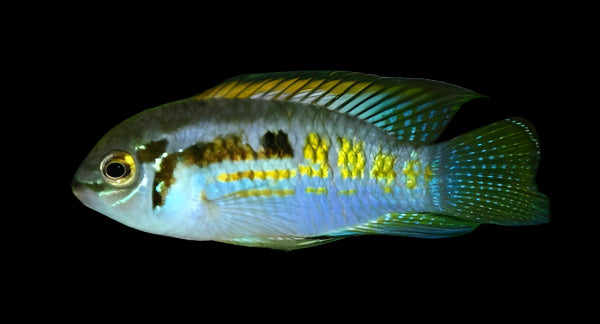SKU:CSA1887S
SMILING DWARF ACARA (Laetacara araguaiae) 1-1.5" (2.5-4cm) 2404
SMILING DWARF ACARA (Laetacara araguaiae) 1-1.5" (2.5-4cm) 2404
Out of stock
Couldn't load pickup availability
Araguaia Dwarf Acara (Laetacara araguaiae)
Origin: Wild Brazil
Locale: Rio Araguaia
Diet: Insectivore and micropredator, will accept most prepared and frozen foods
Adult Size: 2.5″+
Recommended Tank Size: 15+ gallons
Compatibility: Generally peaceful, but can be territorial when breeding
Preferred Water Parameters
pH: 6.5 – 7.2
Temp: 76-82F
Ammonia: 0ppm
Nitrite: 0ppm
Nitrate: <30ppm
This species was known as L. sp. ‘Buckelkopf’ in the aquarium hobby prior to publication of its official description.
The genus Laetacara currently contains seven valid species and L. araguaiae can be distinguished from all congeners by possessing 7-8 dorsal-fin rays (vs. 9–10 in L. dorsigera, L. fulvipinnis and L. thayeri, 8–9 in L. curviceps and L. flamannellus, and 9–11 in L. flavilabris).
It further differs from L. dorsigera by possessing a narrow ectopterygoid (vs. wide), lesser head depth (80.0–88.7 % mm HL vs. 90.2–96.3 % mm HL), a shorter snout (snout length 26.7–32.2 % mm HL vs 33.0–37.9 % mm HL) and more scales in the longitudinal series (23–25 vs. 21–22).
It can be told apart from L. curviceps, L. dorsigera and L. flamannellus by lacking a dark spot on the dorsal-fin base (vs. possessing), from L. thayeri by possessing cycloid scales on the sides of the head (vs. ctenoid scales)and presence of a dark spot at the caudal-fin base (vs. absence), from L. flavilabris by having fewer total vertebrae (24 vs. 26) and fewer scales in the upper lateral line (12–14 vs. 15–18), and from L. fulvipinnis by possessing fewer scales in the upper lateral line (12–14 vs. 15–17), fewer scales in the lower lateral line (6–8 vs. 8–9) and lack of a dark dot at the edge of each scale on the midlateral portion of the flank (vs. presence).
Share


